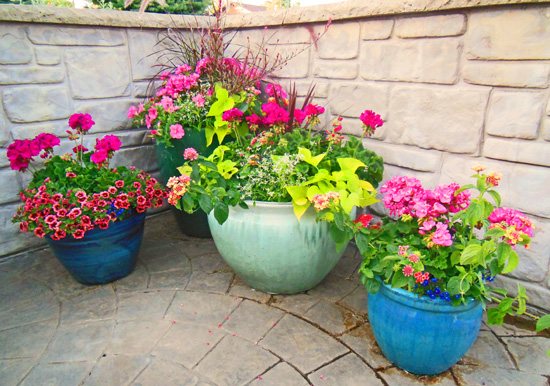Lantana, a captivating shrub renowned for its clusters of brightly colored blooms in shades of orange, yellow, pink, and lavender, is a ubiquitous sight in gardens and landscapes. This sun-worshipping wonder thrives in hot and humid conditions, continuously churning out blossoms throughout the summer. But lantana’s charm extends beyond the flower bed. Its compact growth habit and tolerance for containerized environments make it a perfect candidate for balconies, patios, and even sunny windowsills. Let’s delve into the essential considerations for cultivating a thriving and vibrantly blooming lantana in a container.
Contents
Lantana’s Ideal Environment: Mimicking Sun-Drenched Climes
To understand lantana’s suitability for containers, it’s crucial to replicate its preferred growing conditions. Here are three key environmental factors to consider:
-
Importance of Full Sun Exposure: Lantana basks in the glory of full sun. When grown in containers, position your lantana in a location that receives at least 6-8 hours of direct sunlight daily. This ensures optimal flower production and prevents leggy growth, a condition where the stems become elongated and spindly due to insufficient light.
-
Well-Draining Soil for Optimal Root Health: Lantana abhors soggy conditions. When planting in containers, ensure the potting mix is well-draining. Opt for a commercial potting mix specifically formulated for container plants, or create your own by combining equal parts potting soil, perlite, and coarse sand. This well-aerated mixture allows for efficient drainage of excess water, preventing root rot, a fungal disease that can be detrimental to lantana’s health.
-
Temperature Preferences for Thriving Lantana: Lantana flourishes in warm temperatures. Ideally, maintain daytime temperatures between 70-85°F (21-29°C) for optimal growth and flowering. If residing in a region with cooler nights, consider bringing your container-grown lantana indoors during periods where temperatures dip below 50°F (10°C).
Selecting the Perfect Pot: Setting the Stage for Success
The right pot plays a critical role in lantana’s success in containers. Here’s what to consider:
-
Choosing the Right Pot Size: Select a pot that is slightly larger than the root ball of your lantana. A pot that’s too large can lead to excessive water retention, while a pot that’s too small can restrict root growth and hinder overall plant health. As a general rule, a pot 1-2 inches wider in diameter than the root ball is suitable for a young lantana.
-
Prioritizing Excellent Drainage: Excellent drainage is paramount. Ensure your chosen pot has drainage holes at the bottom to allow excess water to escape. If the pot lacks drainage holes, consider drilling them yourself or opting for a different pot altogether. Sitting water around the roots can lead to root rot, so proper drainage is essential.
-
Material Considerations for Container Aesthetics: Containers come in various materials like plastic, terracotta, ceramic, and glazed pots. While plastic pots are lightweight and affordable, they tend to retain less heat. Terracotta and ceramic pots offer better breathability and drainage but can be heavier. Glazed pots offer a decorative touch but may hinder drainage if not drilled with holes. Choose a material that complements your container garden’s aesthetic while prioritizing drainage needs.
Lantana Care in Containers: A Recipe for Flourishing Growth
With the ideal container selected, here’s how to care for your lantana to ensure abundant blooms:
- Watering Practices: Finding the Balance: Lantana is moderately drought-tolerant once established. Water deeply when the top inch of soil feels dry to the touch. Avoid overwatering, as this can lead to root rot. During hot and dry periods, your lantana may require more frequent watering. Observe the soil moisture and adjust your watering schedule accordingly.
-
Strategic Fertilization for Abundant Blooms: To promote continuous flowering, fertilize your container-grown lantana during its active growing season, typically spring and summer. Apply a balanced fertilizer formulated for flowering plants, following the recommended dilution rate on the product label. Avoid overfertilizing, as this can lead to excessive foliage growth at the expense of blooms. A balanced fertilizer with a ratio like 10-10-10 (nitrogen-phosphorus-potassium) is suitable for lantana.
-
Regular Deadheading to Extend the Floral Display: Deadheading, the removal of spent flowers, is a simple yet effective technique to encourage continuous blooming in lantana. Regularly snip off faded flowers using sharp pruners or shears. This not only improves the plant’s overall appearance but also redirects its energy towards producing new blooms instead of setting seed. By deadheading throughout the season, you can extend your lantana’s vibrant floral display for weeks.
Conclusion
Lantana, with its inherent adaptability and vibrant blooms, thrives remarkably well in containers. By mimicking its preferred growing conditions of full sun, well-draining soil, and warm temperatures, and selecting the right pot with excellent drainage, you can cultivate a flourishing lantana on your balcony, patio, or even indoors by a sunny window. With proper watering, strategic fertilization, and regular deadheading, your container-grown lantana will reward you with a dazzling display of color throughout the summer, adding a touch of sunshine to your space.
-

